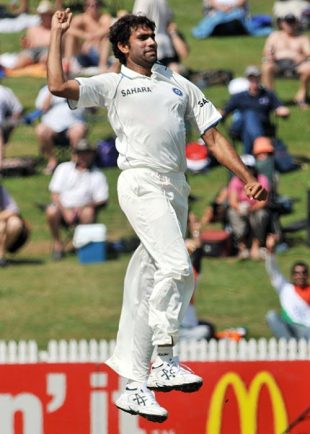|
|
|

In Hamilton, Munaf was the unsung hero as he ended up with more wickets than any other pace bowler in the match
© Associated Press
|
|
| |
MS Dhoni
has spoken variously about the uncertainty the third pace bowler has caused. He is also one of the few who has tended to empathise with an underperforming first-change bowler. Dhoni the wicketkeeper should know. For, the third pace bowler's role is a bit like a wicketkeeper's. More often than not he gets noticed for a 0 for 80 rather than a 2 for 50.
The truth of a third seamer's life, though, is 2 for 50; he rarely gets a chance to take five-fors. So if the pitch is helpful to the bowlers, a major part of the damage is done by the time a third seamer comes on to bowl. His job then is to contain the batsmen, maintain the pressure, so that the chosen ones can strike from the other end.
Munaf Patel
fit that bill in
Hamilton. Zaheer Khan had given India a superb start. Munaf was brought on to replace Ishant Sharma, who then replaced Zaheer at the business end, and got three wickets. Munaf, though, didn't provide any respite from the other end, tying the batsmen down, and came up with a beauty of his own to dismiss Brendon McCullum. But for his poor results in the one-dayers preceding the Test series, he would have gone unnoticed, just like a good self-respecting third seamer should.
In the one-day series, the pitches were flat, and more often than not the New Zealand batsmen got good starts. Munaf would come on during the second Powerplay, when the batsmen would be looking to capitalise. He failed to get noticed in the positive sense of the term.
Wicketkeepers do get noticed for not conceding byes on a minefield. Flat pitches, where batsmen get good starts, are the third pacers' minefields. Nobody wants to be the third seamer, but that's a slot Munaf will have to live with - despite much better statistics when opening the bowling. When he has opened the bowling in ODIs, he has averaged 29.07 and given away runs at 4.52 an over, as opposed to 34.55 and 5.23 when bowling first-change. But Munaf cannot aspire to being an opening bowler now - surely not in the Tests.
Munaf's expensive figures had put pressure on him going into the Tests. On the eve of the Hamilton Test, he was an uncertain starter, which was surprising because he has been India's No. 3 pace bowler for some time. Munaf's fitness history doesn't help. In fact every time the bowlers take him for runs, his fitness comes into question.
Munaf is not a body-language player. His tired, disinterested look worsens when he is being hit around. After all he was the one who broke down in South Africa when India were chasing history in 2006-07. In the
series-decider, when India had set South Africa 211 in the fourth innings, they went in one bowler short. He was in fact making a comeback following an injury. In that light, he is usually seen as a gamble going into a Test match.
"We didn't want him [Munaf] to bowl eight- or nine-over spells, like Ishant [Sharma] or Zaheer [Khan] do," Dhoni said after the Hamilton Test. "He is a short-spell quickie whom you give three to four overs. He has to be at his best when it comes to pace especially, because the wicket was quite flat."
In Hamilton, his first Test in one-and-a-half years, Munaf exceeded the captain's expectations. He started off with a seven-over spell, during which the intensity kept going up. His pace stayed in the late 130s, he was accurate, and kept exploiting the little help that the pitch accorded.
His next spell, a three-over one, wasn't as good, and he was promptly taken off. By the time he came on to bowl for the third time, Daniel Vettori and Jesse Ryder had put on 162 runs. And in the third over of that spell, he got two in two, getting a 140kph yorker to swing in late to dismiss Kyle Mills first up.
That intensity at the fag end of the day, with a frustrating partnership on, would have pleased Dhoni. "There was not much help for the seamers," Dhoni said. "[He had] to bowl in right areas, to bowl with a bit of pace, to be consistent with line and length. That's what he did, so we're quite happy with his performance." In the second innings Dhoni reverted to the original plan of giving Munaf short bursts. He bowled one over of fantastic reverse-swing to get the nightwatchman Mills out off the last ball of the third day. Munaf ended up with more wickets than any other pace bowler in the match.
There is still some way to go, but it would be fair to say India are now one step closer to finding a solution to the third-pacer puzzle. Munaf has quite a few notions - not unfair ones - to disprove, though. A third seamer should be prepared to bowl longer spells. Questions will be asked if it has something to do with his fitness. If he goes through the series with the same intensity and results, the final block of this largely settled team could fall into place.
Sidharth Monga is a staff writer at Cricinfo

